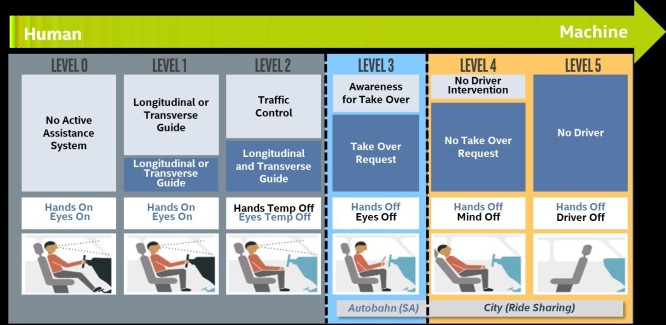By: Jenny Doan
Many of us own a technological device and have experienced that these devices aren’t perfect. The apps downloaded onto smart devices can crash or freeze unexpectedly. This indicates that the software in phones, laptops, and other devices aren’t designed to operate for extended periods of time without crashing or freezing. The software employed in driverless vehicles is not any different. A computer malfunction in the car—even just a minor one—could easily cause a far worse accident than anything that human error might incur. Thus, the rise of driverless cars is a very tenuous plan for the future since these cars are vulnerable to getting hacked, involve legal complications, and cause unemployment.
According to the U.S. National Highway Traffic Safety Administration, there are six classifications of car autonomy. There’s a spectrum for cars that have self-driving technology in them, ranging from minimal technology to maximal technology. The first type of car is at level zero, which has no self-driving capabilities at all. The human does all of the driving from the steering to the braking. Next, a vehicle at level one can assist a driver with either steering or braking, but not with both at the same time. Vehicles at levels zero and one require the driver’s hands to be on the wheel and their eyes to be on the road at all times.
 Harvard Business School. Self Driving Car Levels of Autonomy. 18 Nov. 2016.
Harvard Business School. Self Driving Car Levels of Autonomy. 18 Nov. 2016.
The next type of vehicle is at level two, which can assist the driver with both steering and braking simultaneously. Some of a level-two vehicle’s features include adaptive cruise control and lane centering. Furthermore, a level-three vehicle requires a driver to be in the car, but the driver isn’t expected to be aware of everything at all times, unlike vehicles with levels one and two automation. A level-four vehicle is capable of doing all of the driving, but not under circumstances such as rain or snow. Finally, a level-five vehicle has full autonomy and a human driver isn’t required at all. If the level-zero vehicle is the one that you drive then the level-five vehicle is the one that drives you.
Since these vehicles have technological elements in them, “there’s a vast array of automation that can be remotely hijacked,” states Andy Greenberg, a writer for Wired magazine. To test this theory, two computer security researchers, Charlie Miller and Chris Valasek performed an experiment to test how easy it was to hack into one type of autonomous vehicle—the Jeep Cherokee, a level-two vehicle. For the experiment, Greenberg volunteered to drive the vehicle while Miller and Valasek would be hacking it. The experiment is a simulation of what it’d feel like for someone to be driving a vehicle while it’s being hijacked by an invisible, virtual force.
Greenberg was fully aware that Miller and Valasek would hack the car, but he didn’t know specifically how they’d be doing it. It wasn’t until the experiment began that he found out. Greenberg was driving at 70 miles-per-hour in downtown St. Louis, Missouri when the researchers started testing him. Miller adjusted the temperature in the car; Greenberg wasn’t touching the dashboards when the vents of the Jeep Cherokee started releasing cold air at the maximum setting. Next, Valasek switched the radio’s calm melody to the local hip hop station, blaring rap music at full volume.
Greenberg tried spinning the volume knob left to decrease the noise but it was out of his control. Then Miller activated the windshield wipers and the wiper fluid began squirting, eventually blinding Greenberg’s view of the road. As a final touch, Valasek kills the engine and the Jeep slows to a crawl, in the middle of the highway. Greenberg presses on the gas pedal, but the car doesn’t budge; he’s lost control of his car.
In Miller and Valasek’s experiment, they employed a hacking technique called a zero-day exploit, which means that they can target any Jeep Cherokee, via the Internet. With just a laptop, the researchers can send commands through the Jeep’s entertainment system to its steering, brakes, and transmission. In the comfort of their own home, miles away from Greenberg, they managed to hijack his car. This experiment underscores that the technology in self-driving cars is flawed due to its susceptibility to getting hacked. A factor to be aware of is that the Jeep Cherokee is only a level-two vehicle on the NHTSA scale. Imagine the wide array of possibilities for hackers if it were a level-five vehicle.

Curtis, Whitney. “Charlie Miller and Chris Valasek.” Wired.com, Ladue, 1 July 2015
Technology isn’t the only complication that’s included in self-driving cars. The laws aren’t standardized for who’s at fault when there’s a crash involving a driverless car. There’s currently no legal precedent for how a case would be handled. For instance, whose fault is it if a fully autonomous vehicle hits or gets hit by another car. The passenger sitting in the front seat? The car manufacturer who built the car? The software developer who created the faulty code? Whose insurance will pay for the damage?
In my opinion, it depends on who hit whom in the accident. If the non-autonomous car hits the driverless car then the driver of the other car is evidently guilty. If the driverless car hits another car or a pedestrian then the software developer is at fault; the developer is responsible for the flawed code of the car. The software developer built the entire blueprint for the car and is responsible for all stages of the car’s development, from start to finish. The manufacturer only builds the car based on the software developer’s ideas and is only involved in one part of the process, the building process. Ultimately, the software developer is responsible for damages caused by any crashes involving driverless cars.
Furthermore, the rise of driverless cars will lead to the loss of many jobs worldwide. Many people will lose their jobs to self-driving cars since their manual driving skills would become obsolete. There are currently over 3.9 million truck drivers in the U.S. and over 3.9 million Uber drivers worldwide, according to Mansoor Iqbal, writer for Business of Apps. There are many people who work for GrubHub or UberEats to deliver food or groceries to people’s doorsteps. These self-employed workers are reliant on app users to feed themselves or their families. Their ability to fend themselves won’t happen if they all lose their paychecks. Therefore, if autonomous vehicles become more prevalent then millions of people will become structurally unemployed.
In conclusion, driverless cars are a very tenuous plan for the future since they’re vulnerable to getting hacked, involve legal complications, and cause unemployment. According to Andy Greenberg of Wired Magazine, Charlie Miller and Chris Valasek hijacked his level-two car from miles away causing him to lose full control of his car. Also, the legal complications of crashes, although complicated, points to the software developer, when the driverless vehicle malfunctions and crashes. The software developer is responsible for the erroneous code that led to the car’s crash. The rise of driverless vehicles will also cause many workers to become jobless.
